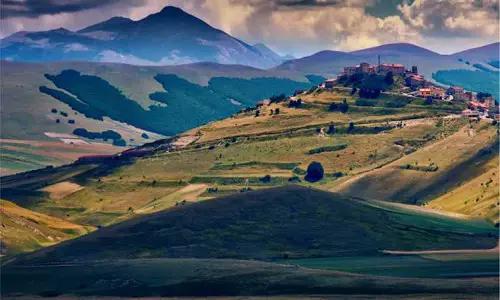Norcia, Land of the Prized Italian Black Truffle
Norcia, Land of the Prized Italian Black Truffle

Discover charming Norcia, a beautiful ancient village on the Sibylline Mountains, in Central Italy, and the divine food products of the area in an unforgettable tour throughout Umbria.
One cannot speak about black truffle without mentioning Norcia: in fact, Tuber Melanosporum Vitt is a prized black truffle commonly known in Italy as Tartufo nero di Norcia (Nursia Black Truffle).
This equisite Black Truffle grows in a hilly and mountainous area in Umbria, in well drained, porous and lime-rich lands. It has a sweet smell and it can be fully appreciated both raw and cooked (for a great pairing, use it with the meat main curses).
At the end of February there is an important Italian Black Truffle fair “Nero Norcia” where you can taste all the gastronomic specialties of Umbria cuisine, and especially those with truffle, of course.
But truffle is not the only delicious food of the area. Norcia gives its name to the traditional art of processing and storage pork, the “Norcineria”. The Prosciutto Crudo di Norcia, an artisanal Italian ham, is an IGP production, an important quality mark. The “Norcina” is also the name of a white pasta sauce made with the typical products of Norcia: sausages, black truffle and cream.
What to see in Norcia
We can say that a journey to Norcia and its surroundings is a real voyage for your senses and your spirit: villages surrounded by nature, ancient hermitages, the truffle aroma, the taste of artisanal salami seasoned with extraordinary extra virgin olive oil an accompanied with a glass of good red wine.
Norcia is located in the South-East part of Umbria (see the umbria map below), and was founded by the Sabines, on the Sibylline Mountains. This area has been inhabited since the Neholitic age, and probably its name comes from the Etruscan goddess of fortune “Norsia”. We can trace back the history of Norcia by the words of the ancient writer Virgil who mentions Ufens, the commander of the Norcian troops, when he talks about the fight between Turnus and Aeneas in the Aeneid.
During the Roman domination Norcia was a Municipality, while in the Middle Ages it was under jurisdiction of the Papal State.
Norcia was also the birthplace of St. Benedict. Benedict of Nursia is famous for having structured Western monasticism: after his death more than a thousand monasteries followed the Benedictine rule “prey and work”. In 1964 Paul VI proclaimed him patron saint of Europe. The Benedictine monks created a canal system surrounding Norcia: a network of irrigation channels that increased land productivity.
The oldest part of Norcia is surrounded by a still intact circuit of walls built in the 14th century, standing despite the many earthquakes that rocked this land. In the main square you can find the most important Norcia buildings.
Saint Benedict Church
St. Benedict had a twin sister, Scolastica, who became a Saint too. St Benedict Church was built in the place where she was born. The church’s portal is decorated with a sculptural group representing the Virgin and Child flanked by the two saints. In the crypt you can see the remains of Roman walls, while outside, under a porch, there are large stone jars, anciently used as units of measure.
Norcia Town hall
Next to the church you can visit the 13th century town hall, with staircase and bell tower. Inside there is the Gothic reliquary of St. Benedict.
In front of the town hall is the Castellina, a fortified residence built by the Papal State during its domination of this region. Before becoming a museum it was hosted the ancient town hall.
Continue the tour of Norcia’s churches and not far from the Castellina, you can see the Cathedral of Santa Maria Argentea, a Renaissance church. The Gothic churches of St. Augustine and St. Francis are notable too.
If it’s sunny we recommend you to continue the tour and to reach Castelluccio di Norcia, a small village perched on a hill. Between late June and early July stop on your way to Castelluccio and enjoy the countryside which walk becomes particularly striking because of the flowering of the fields, wonderful to see and photograph. The Sibylline Mountains also offer many activities for tourists wishing to relax and practice outdoor sports: horseback riding, hiking, but also canoeing, rafting and gliding.
What to see in Umbria
If you are planning a journey among the Italian central regions program also visit these villages in Umbria: Orvieto, Spoleto, Assisi, Perugia, Gubbio and Cascia. A voyage back into the history, through beautiful landscapes and ancient flavors to fight the stress of city life.
Images:
Norcia panoramic view, CC BY SA 2.0
Italian ham prosciutto crudo CC 2.0
Norcia main square CC 2.0
Blossoming Castelluccio di Norcia CC 2.0
Norcia town hall CC 2.0
This site contains product affiliate links. We may receive a commission if you make a purchase after clicking on one of these links.


